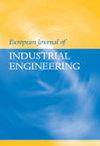Critical factors for sustaining lean manufacturing in the long-term: a multi-method study
IF 1.9
4区 工程技术
Q3 ENGINEERING, INDUSTRIAL
引用次数: 1
Abstract
In recent years, lean manufacturing (LM) has been used to improve the operational performance of organisations by improving the productivity, quality and profitability of their operations. However, some authors claim that these organisations are struggling to implement and maintain lean initiatives in a sustainable way over time. This paper proposes a list of critical factors for sustaining LM in the long-term. We used a multi-method research approach. First, we generated a list of critical factors for sustaining LM in the long-term using the systematic literature review approach. Subsequently, interviews with experts were used to refine these factors. Following this, two case studies were performed, and the results passed through another round of interviews with experts to ensure the robustness of the results. The main result of the research is a list of 19 LM sustainability factors. To the best of the authors' knowledge, this is the first research to propose a scientifically validated list of critical factors for sustaining LM. The contribution of this work lies in consolidating the lean sustainability factors widely found in the literature. In practical terms, the proposed list can guide managerial efforts towards sustaining lean in the long-term. [Submitted: 22 April 2021; Accepted: 29 December 2021]长期维持精益生产的关键因素:多方法研究
近年来,精益制造(LM)已被用于提高组织的运营绩效,通过提高其运营的生产力,质量和盈利能力。然而,一些作者声称,随着时间的推移,这些组织正在努力以可持续的方式实施和维护精益计划。本文提出了长期维持LM的关键因素清单。我们采用了多方法研究方法。首先,我们使用系统的文献回顾方法生成了长期维持LM的关键因素列表。随后,与专家的访谈被用来完善这些因素。在此之后,进行了两个案例研究,结果通过另一轮专家访谈,以确保结果的稳健性。研究的主要结果是列出了19个LM可持续性因素。据作者所知,这是第一个提出一个科学验证的维持LM的关键因素列表的研究。这项工作的贡献在于巩固了文献中广泛发现的精益可持续性因素。在实践中,建议的清单可以指导管理层努力长期维持精益。[提交:2021年4月22日;录用日期:2021年12月29日]
本文章由计算机程序翻译,如有差异,请以英文原文为准。
求助全文
约1分钟内获得全文
求助全文
来源期刊

European Journal of Industrial Engineering
工程技术-工程:工业
CiteScore
2.60
自引率
20.00%
发文量
55
审稿时长
6 months
期刊介绍:
EJIE is an international journal aimed at disseminating the latest developments in all areas of industrial engineering, including information and service industries, ergonomics and safety, quality management as well as business and strategy, and at bridging the gap between theory and practice.
 求助内容:
求助内容: 应助结果提醒方式:
应助结果提醒方式:


